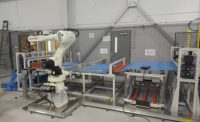In the world of assembly, ABB is known primarily for its leading-edge industrial robots. But, there’s much more to this multinational corporation, which operates 300 manufacturing plants in 100 countries, has nearly 150,000 employees, and reported global revenue of $42 billion in 2013.
The company reorganized in 2010 into one corporate and five production divisions. Robots are assembled at plants in the discrete automation and motion division. More than 200,000 have been installed since 1988.
Other production divisions include process automation, power systems, power products and low-voltage products. The latter produces switches, control products, wiring accessories, enclosures, cable systems and circuit breakers to protect equipment and people from electrical overload.
ABB SACE S.p.A. is part of the low-voltage products division, and the company operates three plants in Italy. One is located in Frosinone, which is about 90 minutes south of Rome. Since 1988, workers there have assembled electronic and thermomagnetic circuit breakers.
The plant operated without robots until 1993, when ABB installed two of its own to handle soldering tasks. Seeing the increase in production and decrease in rejects, Production Engineering Manager Savina Fardelli and Process Engineering Manager Marco Dolce decided to install an IRB 140 on the packaging line in 2000. They also painted it white rather than the traditional orange “to communicate a sense of cleanliness, luminosity and surgical precision,” says Fardelli.
In 2006, many more robots were installed to handle soldering, assembly and packaging. Models of varying sizes and capabilities were selected, including the IRB 120, 140, 360, 1600, 2400 and 4600. Four years later, several welding robots arrived.
By the start of 2013, more than 40 robots were in operation—half performing welding and assembly functions, and half being used for quality control, testing, pick-and-place and packaging applications. In March 2013, the plant started a new assembly line featuring several more robots.
Dolce and Fardelli say that production has more than doubled without an increase in the number of employees since 2000. That year, the plant produced around 1 million low-voltage case circuit breakers. Today, it produces more than 2.5 million molded case circuit breakers, plus another 75,000 air circuit breakers.
The engineers proudly point out that no workers have been laid off during this time. Rather, they are retrained and given more sophisticated assignments. Retraining is ongoing.
Increased production isn’t the only benefit provided by the robots. Product quality is improved, and energy costs are 30 percent lower due to increased production line efficiency.
Robots also make less noise than nonrobot automated systems, lowering the plant’s overall sound level so it’s more tolerable for workers. Plus, the robots save valuable space on the factory floor. For example, production-line space requirements with an IRB 120 shrank from 200 square meters to 50 square meters.
Dolce points out that production lines with robots are easier to design and setup. An automated nonrobot system may require three engineers to
design and considerable time to construct, whereas a line with robots requires one programmer and, at maximum, a few days to develop.
Interestingly, the robots at Frosinone are not used at their full speed. This is because speed is not as important for circuit-breaker production as it is for, say, high-volume consumer products. Instead, Fardelli and Dolce emphasize the robots’ precision, accuracy and flexibility.
For more information on industrial robots, call 248-391-9000 or visit








